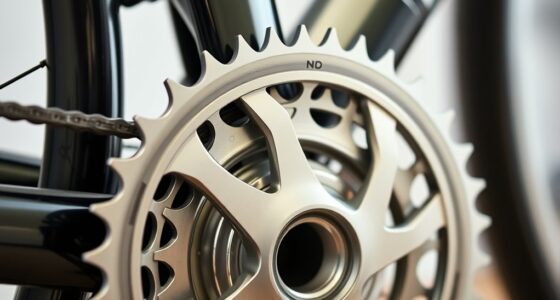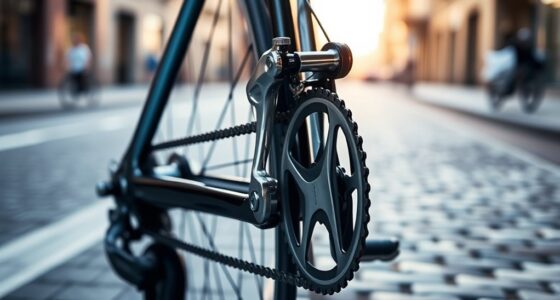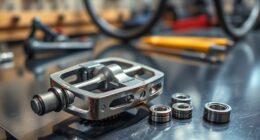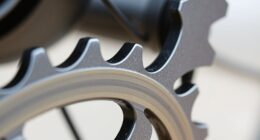Hydraulic disc brakes outperform mechanical ones in all-weather stops by providing consistent, smooth braking even when wet, muddy, or icy. They resist moisture, dirt, and debris better, reducing fade and maintaining better control. Hydraulic systems require less maintenance and offer more reliable modulation, giving you better confidence in severe conditions. If you want to understand why hydraulic brakes are the top choice for all-weather riding, you’ll find useful insights ahead.
Key Takeaways
- Hydraulic disc brakes provide more consistent, reliable stopping power in wet, muddy, and snowy conditions.
- Sealed hydraulic systems resist water, dirt, and corrosion better than exposed mechanical cables.
- Hydraulic brakes offer smoother modulation and better control during severe weather.
- Mechanical brakes are more prone to cable stretch, corrosion, and inconsistent performance in adverse conditions.
- Overall, hydraulic disc brakes outperform mechanical ones for all-weather stopping reliability.
Understanding the Basic Differences Between Hydraulic and Mechanical Brakes

When it comes to stopping power on your bike, understanding the basic differences between hydraulic and mechanical brakes is essential. Hydraulic brakes use brake fluid to transmit force from the lever to the caliper, providing smooth and consistent braking. This system relies on sealed lines, so you don’t need to worry about cable tension. In contrast, mechanical brakes operate via a cable, which pulls the caliper when you squeeze the lever. Proper cable tension is vital for effective braking, as too loose or tight can reduce performance. Hydraulic systems generally require less maintenance and offer more precise modulation, while mechanical brakes are simpler to adjust and repair. Knowing these distinctions helps you choose the best system for your riding style and maintenance preferences. Understanding the basic differences ensures you make an informed decision tailored to your needs.
How Each System Handles Wet and Muddy Conditions

When riding in wet or muddy conditions, your braking performance can vary greatly between hydraulic and mechanical systems. You’ll want to think about how each handles water and dirt, especially regarding stopping power and reliability. Let’s explore how these systems perform under challenging weather and terrain. Incorporating regular maintenance during your maintenance and riding can significantly influence the effectiveness of your brakes in adverse conditions, ensuring you stay safe and in control. Properly maintaining brake components helps prevent issues caused by debris and corrosion, which are common in harsh environments.
Wet Weather Braking Power
In wet and muddy conditions, braking performance can considerably differ between hydraulic and mechanical disc brakes. Hydraulic systems use brake fluid, which transfers force smoothly and consistently, maintaining strong braking power even when conditions are slick. Properly sealed brake fluid helps prevent moisture contamination, preserving performance. Mechanical brakes rely on cable tension, which can be affected by mud and water, reducing responsiveness. Pad material also plays a role; softer compounds grip better in wet weather but wear faster, while harder pads last longer but might struggle to stop effectively when wet. Furthermore, sealing technology in hydraulic systems helps prevent water ingress, ensuring consistent performance. Overall, hydraulic brakes tend to deliver more reliable wet-weather braking, thanks to consistent force transfer and better sealing against moisture, making them the preferred choice for all-weather riding. Additionally, brake system durability is a key factor in maintaining reliable performance over time in challenging conditions.
Muddy Terrain Performance
How well your brakes perform on muddy terrain depends largely on their design and how they handle debris and moisture. Hydraulic brakes, with enclosed systems and brake fluid, resist mud buildup better, maintaining consistent pressure even when debris gets in. The fluid’s resistance to water contamination helps prevent brake fade, ensuring reliable stops. Mechanical systems, relying on cables and exposed components, are more vulnerable to mud and grit, which can cause sticking or reduced responsiveness. Pad materials also matter; softer compounds may grip better in muddy conditions but wear faster, while harder pads resist dirt buildup longer. Overall, hydraulic brakes tend to perform more reliably in muddy terrain because their sealed design and quality pad materials help maintain consistent braking power despite dirt and moisture.
Water and Dirt Resistance
Hydraulic disc brakes generally handle wet and muddy conditions better than mechanical systems because their sealed design keeps out water and debris, maintaining consistent pressure. The brake fluid inside the system resists contamination, ensuring hydraulic efficiency even in challenging conditions. This means your stopping power remains reliable when riding through rain, puddles, or mud. Since the hydraulic system is protected from dirt and water, it’s less likely to experience corrosion or corrosion-related issues. Mechanical brakes, with exposed cables and components, are more vulnerable to dirt and moisture, which can cause sluggish response or reduced braking power. Overall, hydraulic brakes provide more consistent performance in all-weather stops, thanks to their sealed design and the stability of brake fluid under adverse conditions. Additionally, automation technologies in manufacturing can improve the durability and reliability of hydraulic systems, making them even more effective in tough riding environments.
Stopping Power and Modulation in Various Weather Scenarios

Ever wonder how different brake systems perform when weather conditions turn hostile? Your stopping power and modulation depend heavily on the system’s ability to respond reliably. Hydraulic brakes generally offer consistent modulation because brake fluid provides smooth pressure transfer, even in wet conditions. Mechanical systems rely on cable tension, which can fluctuate with dirt or moisture, affecting power. Additionally, proper dog dental care can contribute to overall health, which is crucial for active pets in various weather conditions. Consider these factors: 1. Hydraulic brakes maintain steady pressure despite rain or mud. 2. Mechanical brakes may suffer from increased cable tension, reducing stopping power. 3. Brake fluid helps hydraulic systems resist weather-related inconsistencies. 4. Cable tension adjustments are vital for mechanical brakes to guarantee effective modulation. In challenging weather, hydraulic brakes excel in delivering reliable stopping power and smoother modulation, while mechanical systems require extra attention to maintain performance.
Maintenance Needs and Durability in Harsh Environments

When riding in harsh environments, the maintenance needs and durability of your brake system are vital for reliable stopping power. Hydraulic brakes generally require less frequent upkeep, as their sealed systems resist dirt and moisture, maintaining consistent performance. Mechanical brakes, on the other hand, may need more regular adjustments and cable replacements, especially in muddy or wet conditions. Durability also influences aesthetic appeal; a well-maintained brake system looks clean and functions smoothly, enhancing your bike’s overall look. Additionally, brand reputation plays a role—trusted brands often produce more durable, weather-resistant components that withstand tough conditions longer. Proper paint sprayer maintenance and selecting high-quality, weather-resistant components can further extend your brake system’s lifespan in challenging environments. Investing in high-quality brakes suited for harsh environments ensures safety, reduces downtime, and preserves the aesthetic appeal of your bike over time.
The Effect of Temperature Changes on Brake Performance

Temperature changes can markedly impact brake performance, especially during extreme heat or cold. In hot weather, brake fluid can overheat, leading to vapor lock and reduced braking power, while cold temperatures can thicken the fluid, causing sluggish response. For hydraulic systems, brake fluid compatibility is vital—using the wrong type may worsen performance issues under temperature stress. When temperatures fluctuate, you might need to perform hydraulic system bleeding more often to remove air bubbles caused by fluid expansion or contraction. Keep these in mind:
- Hot weather risks brake fluid boiling, reducing effectiveness.
- Cold weather thickens brake fluid, delaying response.
- Brake fluid compatibility affects system reliability.
- Regular bleeding ensures smooth brake operation despite temperature swings.
- Proper fluid maintenance can help mitigate temperature-related performance issues. Additionally, understanding how temperature fluctuations influence fluid behavior can help you anticipate and prevent potential failures.
Understanding these factors helps you maintain consistent braking in all weather conditions.
Ease of Installation and Adjustment in Challenging Conditions

Installing and adjusting disc brakes in challenging conditions can be demanding, but choosing the right system makes it easier. Hydraulic brakes generally require less frequent adjustments, thanks to their self-adjusting mechanisms, which can be a huge advantage in harsh environments. When it comes to brake pad materials, those with sintered or ceramic pads tend to perform better and need less frequent replacement, simplifying maintenance. Mechanical systems, however, often need manual adjustments, especially if dirt or moisture interfere with cable tension. Hydraulic fluid types also matter; mineral-based fluids resist water better, reducing issues during wet conditions. Overall, hydraulic brakes tend to be more straightforward to set up and maintain in tough conditions, saving you time and effort during installation and future adjustments. Using high-quality brake fluids can also extend the lifespan of hydraulic components and ensure consistent performance in all weather situations.
Cost Considerations for All-Weather Usage

Hydraulic disc brakes often come with a higher upfront cost compared to mechanical systems, but their durability and low maintenance can make them more economical over time, especially in all-weather conditions. Over time, you might save on parts and repair costs due to their reliability. Consider these factors:
- Brake fluid compatibility ensures smooth operation and reduces the need for frequent replacements.
- Hydraulic systems require minimal cable tension adjustment, keeping performance consistent in diverse weather.
- Mechanical brakes may need regular cable tension adjustments, which can be challenging in wet or muddy conditions.
- Hydraulic systems generally resist dirt and moisture better, lowering maintenance costs and downtime.
- The performance consistency of hydraulic brakes in varying weather conditions often leads to safer and more reliable stopping power.
- The reliable performance of hydraulic systems is also supported by their resistance to environmental contaminants, reducing the likelihood of brake failure during adverse weather.
- Additionally, hydraulic systems often feature self-adjusting mechanisms, which help maintain optimal brake function without manual intervention in changing conditions.
- Proper maintenance practices can further extend the lifespan and effectiveness of hydraulic brakes, ensuring consistent performance over time.
- The environmental resistance of hydraulic systems makes them especially suitable for harsh weather conditions where dirt, mud, and water can impair mechanical systems.
Ultimately, while initial expenses are higher, hydraulic brakes often prove more cost-effective long-term for all-weather riding.
User Experience: Feel, Control, and Confidence in Different Climates

Your ability to modulate and control your brakes directly impacts your confidence on the road, especially in changing weather. Hydraulic brakes often offer more consistent stopping power in wet conditions, giving you peace of mind. Understanding how each system feels and responds helps you choose the right setup for all-weather riding.
Modulation and Precision
When it comes to modulation and precision, hydraulic disc brakes generally offer smoother and more consistent control, allowing you to finely tune your braking force with ease. With brake fluid transmitting force directly from the lever, you can modulate braking more precisely than mechanical systems. Your control depends heavily on factors like pad material, which affects grip and feedback, and the quality of the hydraulic system.
Imagine:
- Feeling a gentle, predictable squeeze without sudden jerks.
- Adjusting brake force smoothly as you approach a stop.
- Relying on consistent pad material performance in varying conditions.
- Fine-tuning your braking for delicate maneuvers or emergency stops.
This combination provides a confident, intuitive feel that enhances your all-weather riding experience.
Consistent Stopping Power
Consistent stopping power is essential for building confidence and ensuring safety, especially when riding in varying weather conditions. Hydraulic disc brakes maintain reliable performance because the brake fluid delivers steady pressure, reducing the risk of fade during extended use. Their pad materials are designed to withstand high temperatures and resist moisture, maintaining effective friction. Mechanical disc brakes, on the other hand, depend on cable tension, which can fluctuate with temperature changes and dirt, leading to inconsistent braking. The choice of pad materials also influences performance; high-quality pads provide predictable feel and reliable bite, regardless of climate. Overall, hydraulic systems tend to offer more consistent stopping power because their components are less affected by environmental factors, giving you better control and confidence in all weather situations.
Confidence in Wet Conditions
Hydraulic disc brakes generally provide greater confidence in wet conditions because their fluid system delivers reliable, consistent stopping power regardless of moisture. You’ll notice that brake fluid compresses evenly, ensuring smooth, predictable responses even when roads are slick. The pad materials also matter; high-quality compounds resist water and mud, maintaining grip on the rotor. This means you can brake confidently without fear of slipping. Additionally, proper GMC tuning can optimize brake performance for specific driving environments, further enhancing safety in adverse weather. Properly maintaining the sealed hydraulic systems helps prevent water ingress and corrosion, ensuring long-term performance. Consider these factors:
- Consistent brake fluid pressure ensures reliable stops in rain.
- Sealed hydraulic systems prevent water ingress and corrosion.
- Durable pad materials maintain effective grip in wet weather.
- Less susceptibility to moisture-induced fading boosts confidence in all conditions.
All these elements combine to give you better control and peace of mind when riding in wet environments.
Common Failures and Reliability in Severe Weather
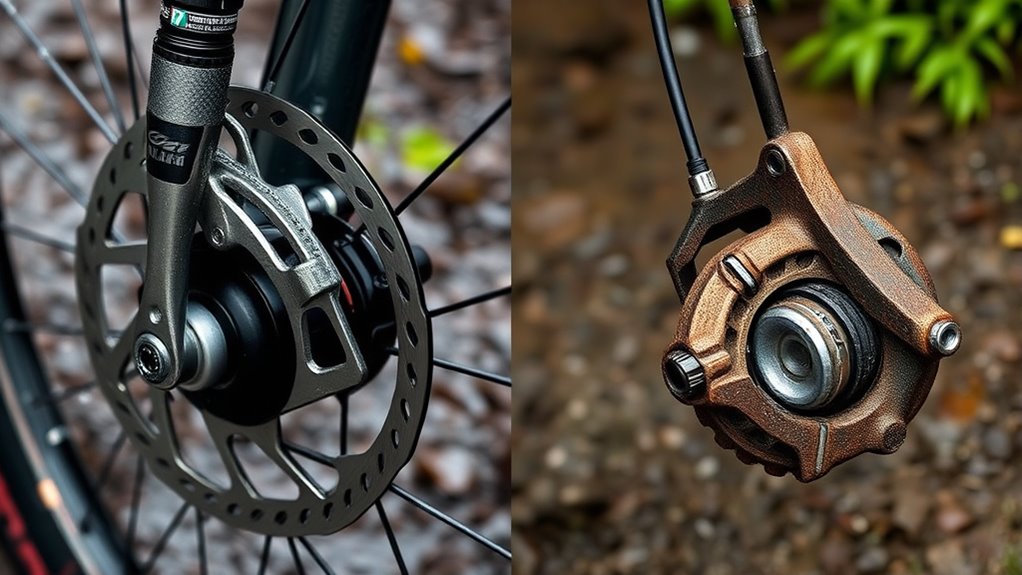
Severe weather conditions can challenge the reliability of both hydraulic and mechanical disc brakes, leading to potential failure when you need them most. Hydraulic brakes rely on brake fluid, which can become contaminated or leak under extreme conditions, causing a loss of braking power. They’re also prone to pad wear, especially when mud, ice, or grit gets into the system, reducing effectiveness. Mechanical brakes face issues like cable stretching or rust, which can hinder proper actuation. Both systems are vulnerable to corrosion if not maintained properly. In freezing temperatures, brake fluid may thicken or freeze, impairing performance. Similarly, pad debris or corrosion can cause sticking or uneven wear, compromising reliability when you need reliable stopping power during severe weather.
Which Brake Type Provides Superior Safety and Performance in All Weather?

When choosing a brake system for all-weather safety and performance, it’s crucial to take into account how each type responds under different conditions. Hydraulic brakes generally offer more consistent stopping power, thanks to brake fluid that maintains pressure even in wet weather. Mechanical brakes, however, rely on cable tension, which can be affected by dirt or corrosion. Consider these points:
- Hydraulic systems provide better modulation, improving safety on slick surfaces.
- Brake fluid helps resist moisture, reducing the risk of brake fade. Moisture resistance is essential for maintaining brake performance during rain or snow.
- Pad wear tends to be more predictable with hydraulic brakes due to smoother application.
- Mechanical brakes may experience increased pad wear and less reliable performance in rain or snow.
- Proper maintenance and understanding of air quality can also influence overall safety during riding in various weather conditions.
Ultimately, hydraulic brakes tend to deliver superior safety and performance in all weather.
Frequently Asked Questions
How Do Hydraulic and Mechanical Brakes Perform in Extreme Cold Conditions?
In extreme cold, hydraulic brakes can face issues with brake fluid viscosity, making them feel less responsive until the fluid warms up. Mechanical brakes rely on cable tension adjustment, which can loosen or stiffen in cold, affecting braking power. To maintain peak performance, you should regularly check and adjust cable tension and ensure your hydraulic fluid is rated for low temperatures. Proper maintenance keeps your brakes reliable in harsh weather conditions.
Which Brake Type Is Easier to Repair During Severe Weather?
When it comes to repairing during severe weather, mechanical brakes are easier for you. You can quickly perform brake pad replacement without special tools, and bleeding the system isn’t necessary. Hydraulic brakes, however, require bleed system maintenance, which can be tricky in cold, wet conditions. So, if you need a straightforward repair in bad weather, mechanical brakes are your best bet for simplicity and quick fixes.
Can Either System Handle Sudden Stops on Icy Surfaces Effectively?
You wonder if either brake system handles sudden stops on icy surfaces effectively. Hydraulic brakes often perform better because hydraulic fluid viscosity remains stable in cold weather, providing consistent braking power. However, brake pad wear can affect performance over time, regardless of system. Mechanical brakes might be less affected by fluid issues but can suffer from cable slack. Both need proper maintenance to guarantee safety in icy conditions.
Are There Specific Maintenance Tips for All-Weather Brake Reliability?
Think of your brakes like a trusty compass—you need them reliable in all weather. To guarantee this, regularly check for fluid leakage and inspect brake pad replacement needs. Keep your hydraulic fluid clean and at the right level, and tighten any loose components. Just like maintaining a compass keeps your direction true, consistent maintenance ensures your brakes perform confidently, rain or shine.
How Do Brake Systems Impact Rider Safety During Heavy Rain and Snow?
During heavy rain and snow, your brake system greatly impacts rider safety by providing reliable stopping power. Hydraulic brakes tend to resist brake fade better, maintaining consistent performance in wet conditions, while mechanical brakes might squeal more, reducing confidence. You should regularly check for brake squeal, which indicates wear, and guarantee your brakes don’t fade under pressure. Proper maintenance ensures your brakes respond effectively, keeping you safer in all weather.
Conclusion
So, when it comes to all-weather stopping, both hydraulic and mechanical brakes have their strengths. Hydraulic systems often offer better modulation and power in wet conditions, while mechanical brakes are simpler and easier to maintain. But really, isn’t having reliable stopping power in any weather what matters most? Choose the system that fits your riding style and environment, and you’ll stay safe no matter the forecast. After all, aren’t confident stops worth the investment?



